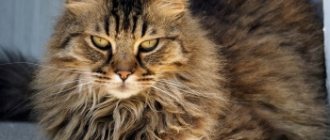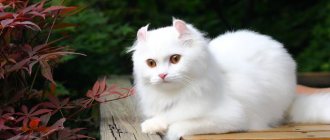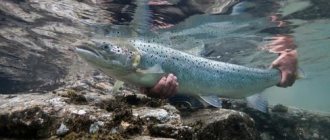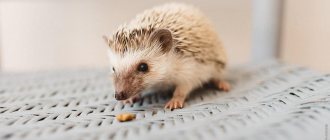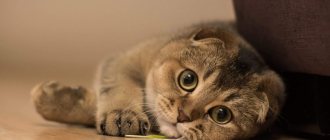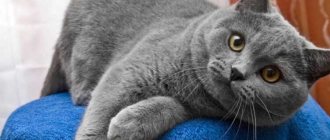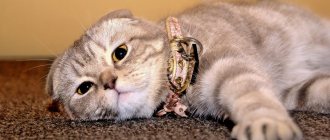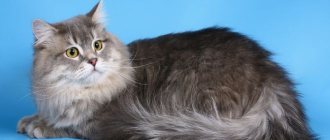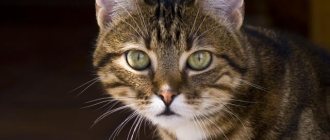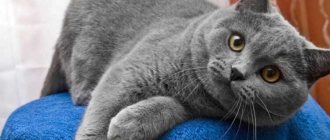A breed with downturned ears
- Fact 1:
In English it is called Scottish Fold - Fact 2:
Ears that curl forward and down are the result of a gene mutation - Fact 3:
Cats live up to 15 years, and sometimes up to 18! - Fact 4:
Cats of this breed can sit like a person, with their lower legs extended in a funny way.
The Scottish Fold is a cat breed native to Scotland that has funny ears that curl downwards due to a mutation.
In the short period of its existence, the breed of Scottish Fold cats (another name is Scottish Fold) has gained incredible popularity among professional breeders and ordinary amateurs. The reason for this mainly lies in the unusual appearance of fold-eared cats: pressed (folded) ears make the face of representatives of this breed very cute, emphasizing their expressive eyes.
The Scottish Fold breed originates from an ordinary domestic cat, which was born on the farm of a Scotsman in the 60s of the last century.
| That cat had a congenital mutation in the form of deformed ears pressed to the head, which the owner of the animal then tried to fix through inbreeding. |
Unfortunately, the resulting offspring exhibited multiple developmental anomalies, and further selection of the breed was suspended.
But thanks to the initiative of breeders from the USA, who began to cross Scottish Fold cats with American and British shorthair cats, the Scottish Fold genes, which are dangerous to health, were defeated. At the same time, the breed acquired some recognizable features that still partly make it similar to the “donor” breeds - these are the body structure features and plush fur characteristic of the “British” and “Americans”.
Appearance of the Scottish Fold and photo
Scottish Folds are medium-sized cats of harmonious build, with strong but graceful bones. The weight of adult cats varies in the range of 4-6 kg, cats - 2.7-4 kg. The legs are straight and muscular, the tail is medium-sized or long, the tip is rounded. A fluffy tail may be a reason for disqualification at a show.
The head is rounded, the chin and jaws are strong and well developed. The nose is short and wide, the eyes are large, wide open, round. The ears are small: the pinnae are pressed to the head and cover the auditory openings, the tips of the ears are directed downwards.
The coat is very soft (reminiscent of plush), short, thick, the guard hair and undercoat form a homogeneous mass. The color can be any: solid or multi-colored, striped, spotted, marbled, bicolor, tabby, color point. The shades of wool are also as varied as possible - blue, lilac, gray, smoky, sand, chocolate, white, black, cream, mixed options. Any eye color, but linked to the coat color, can be yellow, emerald, blue, amber.
Bengal cat
The breed was obtained by crossing an outbred cat with a wild leopard. The breed was bred by geneticist D. Mill. The color scheme of Bengal cats' fur coats is very variable, because animals of different appearances were involved in the breeding of the breed. Typically, the Bengal's fur has a gray or brown tint, and the top of the coat is decorated with dark oblong spots.
The ears of a Bengal cat are oblong in shape. The eyes are almond-shaped and large. The neck is quite long, the body is elongated. The tail is medium, rounded at the end. The coat is short.
Spotted Bengal cats are graceful, sociable, and intelligent. Many are trainable. Despite their wild roots and penchant for hunting and swimming, they do not show aggression. But they may well bring prey for the owner, laying it at his feet.
Where do fold ears come from?
The Scottish Fold breed has this peculiarity: if the kittens' ears remain straight as they grow older, the animals are called Scottish Straight. In general, straight-eared kittens are common, since in order to get good healthy offspring, responsible breeders do not use two fold-eared animals - one of the pair must be straight-eared. When two fold-eared animals mate, weak kittens with developmental pathologies are often born.
The initial cost of a Scottish Fold kitten is 3,000 rubles. The price depends on the presence (or absence) of a pedigree, the titles of the kitten’s parents, and the rarity of the color. If you want to buy a kitten with floppy ears, it is better to get an animal at the age of 3 months. Although the characteristic fold of the ear is formed in the baby on the 18th day of life, only at the age of 3 months it becomes finally clear whether his ears will be pressed or erect.
How to choose a kitten
You should buy a kitten from a well-established nursery - this will minimize the likelihood of health problems for the animal. An experienced breeder will help you choose a pet according to the buyer’s tastes and needs, give recommendations on care and maintenance, and advise a competent veterinarian. The right decision before purchasing would be to visit the exhibition - here you can see the parents of the future pet in real life, without “Photoshop” retouching, or even choose and purchase a kitten right away.
You shouldn’t look for a baby at all - conscientious breeders (people who professionally breed purebred cats) never give away kittens under three months old. By this age, the baby is fully vaccinated, trained in good manners and ready for independent life in a new family. Early weaning from its mother, brothers and sisters often becomes the cause of behavioral problems in the future - in this case, the pet associates itself more with a person than with a cat, and gets along worse with new family members, as well as animals that appeared in the house later.
The optimal age for choosing a small curl is 4 months.
By this time, the formation of the ear curl is completed and it becomes possible to evaluate the breed quality of the kitten. The price of an American Curl from a good nursery depends on the breed class and can vary from one to several tens of thousands of rubles. Animals sold for various reasons without the right to breed cost 10-25 thousand rubles. Babies with good breed potential, intended for further breeding, are sold more expensively - for 30-45 thousand rubles. The most expensive in cost - 50-60 thousand or more - are matured (about a year old) animals with outstanding breed characteristics, but such cats and female cats most often remain in the nursery.
You can buy a Curl cheaper - for several thousand rubles, but most often kittens are sold at this price by breeders who have started producing live goods. They, as a rule, sell babies from 1-1.5 months, without burdening themselves with concerns about good feeding, vaccination, or expert assessment of breed qualities. In such cases, there can be no question of any guarantees of health and breed data.
The breed quality of a Curl is assessed at 4 months of age - when the formation of ears ends
Unusual habits, character and intelligence
Scottish Folds are balanced, moderately playful, and sometimes quite phlegmatic cats that know how to compromise and get along well with all household members (including small children) and pets. They never respond to provocations and aggression, trying to simply avoid conflict if it is brewing.
Scottish Folds are very gentle and affectionate with their owners. They love to be petted, willingly make contact without being intrusive, they know how to understand a person’s mood and show tact. These cats are, in a sense, very intelligent and do not create any particular difficulties in their maintenance: they quickly understand the purpose of the litter box and scratching post, are not picky about food, and can easily tolerate trips and preventive visits to the veterinary clinic.
The unusual appearance of these cats is complemented by funny habits. Scottish Folds can sit with their paws outstretched (like a person sits with their legs outstretched), are able to sleep on their back and can easily stand on their hind legs, stretched out in a column, like meerkats. Owners also note the quick wit and high intelligence of fold-eared cats - pets are easy to train, understand commands and sometimes even watch TV with interest. The voice of fold-eared cats is also unusual, creaky. Meowing resembles grunting.
Maintenance and care
Scottish Fold cats do not require special care. Their short hair does not tangle and hardly sheds, which does not create additional hassle in keeping the house clean. But you still need to comb these cats, and for this you will need a soft slicker brush with rounded needles so as not to scratch the cat’s skin. Scottish Folds love to be brushed, including against the grain. It is enough to comb the animal once a week, and during molting - once every 2-3 days.
As mentioned above, a cat does not damage furniture and walls by scratching if it has a scratching post. If the animal does not grind its claws well enough on the scratching post, they need to be carefully trimmed by 1-2 mm every 2 weeks with special scissors for cat claws (human scissors are not suitable, they only soften the claw).
It is not necessary to wash fold-eared cats more than once every six months, unless the animal suddenly gets thoroughly dirty in something difficult to clean. Even if the owner wants to wash the Scottish Fold more often, it is not recommended to do this more than once every two months, so as not to cause irritation on the cat’s sensitive skin.
Due to the shape of the auricle, the inside of the ears of the Scottish Fold is not as well ventilated as that of ordinary cats, but, as a rule, there are no problems with the ears of this breed. You need to inspect and clean your cat's ears with a cotton swab once a week. For wiping, you can use special hygienic lotions for animal ears. If you find that the inside of your cat’s ear is wet or there is dark discharge, this should alert you and be a reason to visit a veterinarian.
Periodically (sometimes daily) it is necessary to wipe the animal’s eyes from accumulated secretions. A soft, clean cloth soaked in boiled water is suitable for this. You need to examine and brush your teeth 2 times a week.
Among personal belongings, the cat should also have a place to sleep and rest. It is better if it is a play complex with a closed house, an upper open bed or hammock, shelves and posts for climbing and sharpening claws.
Cat food
They are not picky eaters, but it is necessary to follow strict rules in feeding these cats. If you decide to train an animal to eat ready-made dry and wet food, then you need to choose nutritious, but too fatty options from the super premium class. Poultry, rabbit, lamb and fish feeds are suitable.
Since Scottish Folds are not particularly active, it is better to choose food for them labeled “for domestic cats” or “cats with a sedentary lifestyle.” The exception is kittens and young energetic cats, who need to choose foods high in protein and protein.
If the owner wants to feed the fold cat natural food, then beef, rabbit, lean poultry, offal, fermented milk products, boiled egg and boiled sea fish (small pieces 1-2 times a week) are suitable. And as an additive to meat, you need to feed the cat a little boiled rice or buckwheat, give fresh and stewed vegetables, grass (for example, parsed oats).
From time to time you need to give your cat large pieces of meat so that she has to open her mouth wider while chewing. The Scottish Fold has large jaws, which must receive a good load, otherwise the animal may develop problems with its teeth. An adult cat needs to be fed 3-4 times a day, a kitten more often - up to 6-8 times, depending on age.
History of the origin of the American Curl breed
The American Curl is a relatively new cat species whose rise to the top of popularity has had no obstacles along the way.
On a warm summer evening, two small fluffy balls with curled ears nailed to the door of a couple named Ruga, who lived in sunny California. Kind-hearted Grace Ruga was unable to drive the kittens away and took them into her home.
A black cat with curved ears was named Shulamith, and her black and white sister with an equally amazing detail in her appearance was “christened” Panda. The panda lived in the house of hospitable Americans for only a couple of weeks, after which he died in an accident.
Fate was more favorable to Shulamith - the cat lived a long and happy life. Some time after finding a home, Shulamith gave birth to kittens, several of them inherited a gene from their mother's side that makes their ears curl back in a flirtatious manner.
A kitten named Mercedes went to live with his sister Grace, and as time passed, his litter included unusual kittens. American Curls were officially recognized in 1987.
Scottish Fold health
Scottish Fold cats have a breed tendency to diseases of the musculoskeletal system. The gene that provokes pathological changes in the skeletal system is linked to the lop ear gene. Cats with short thick tails and inflexible paws are most prone to musculoskeletal disorders. It is necessary to monitor the health of such pets more closely, regularly visit the veterinary clinic with them and strictly adhere to the diet prescribed by the veterinarian.
But in general, the Scottish Fold is in good health, especially if the breeders from whom the kitten was purchased followed all the nuances of selecting a pair to produce offspring. The average lifespan of Scottish Folds is 12-15 years, but among the representatives of this breed there are many long-livers who have surpassed the 18 year mark.
To protect a cat from viral and infectious diseases, standard vaccination, periodic deworming and protection from external parasites - insectoacaricidal drops, collars, sprays - are required.
